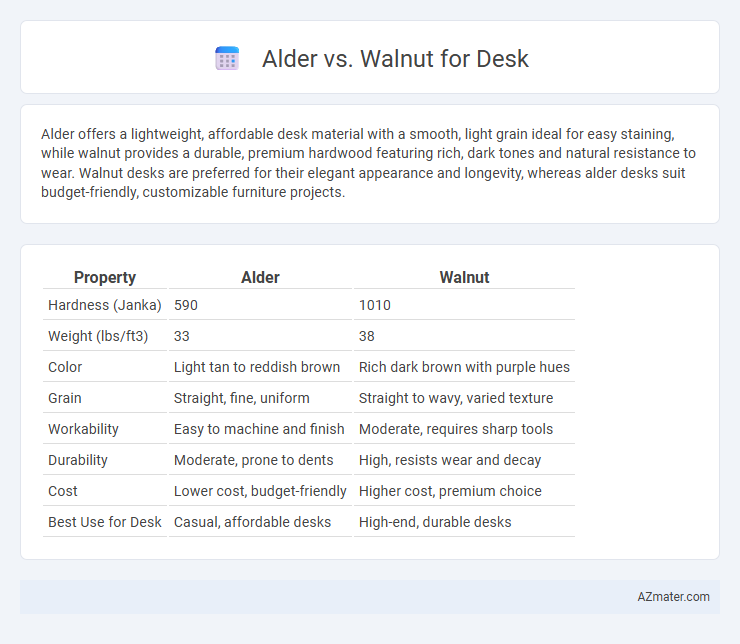Alder offers a lightweight, affordable desk material with a smooth, light grain ideal for easy staining, while walnut provides a durable, premium hardwood featuring rich, dark tones and natural resistance to wear. Walnut desks are preferred for their elegant appearance and longevity, whereas alder desks suit budget-friendly, customizable furniture projects.
Table of Comparison
| Property | Alder | Walnut |
|---|---|---|
| Hardness (Janka) | 590 | 1010 |
| Weight (lbs/ft3) | 33 | 38 |
| Color | Light tan to reddish brown | Rich dark brown with purple hues |
| Grain | Straight, fine, uniform | Straight to wavy, varied texture |
| Workability | Easy to machine and finish | Moderate, requires sharp tools |
| Durability | Moderate, prone to dents | High, resists wear and decay |
| Cost | Lower cost, budget-friendly | Higher cost, premium choice |
| Best Use for Desk | Casual, affordable desks | High-end, durable desks |
Introduction: Alder vs Walnut for Desk Making
Alder and Walnut are popular hardwood choices for desk making, each offering distinct characteristics in color, grain, and durability. Alder features a light, warm tone with a fine, straight grain, making it ideal for stained or painted finishes, while Walnut boasts a rich, dark brown hue with a bold grain pattern that adds natural elegance. Walnut's superior hardness and resistance to wear provide long-lasting durability compared to Alder's softer, more affordable nature suited for budget-conscious projects.
Wood Characteristics: Alder and Walnut Compared
Alder wood offers a softer, lighter tone with a fine, smooth grain, making it ideal for desks that require easy staining and a warm, natural look. Walnut is denser and harder, featuring rich chocolate hues and a pronounced, elegant grain pattern that enhances durability and sophistication. Both woods provide strong structural integrity, but walnut's superior hardness makes it better suited for heavy-use desks.
Durability and Strength Differences
Alder wood is softer and less dense compared to walnut, resulting in lower durability and strength, making it more prone to dents and scratches over time. Walnut features a higher Janka hardness rating, providing superior resistance to wear and impact, which makes it more suitable for heavy-use desks. Choosing walnut ensures a longer-lasting, sturdier desk, while alder offers a more affordable option with moderate durability for lighter use.
Visual Appeal: Grain Patterns and Colors
Alder wood features a smooth, even grain with subtle, uniform patterns and warm tones ranging from pale yellow to reddish-brown, creating a soft, inviting look for desks. Walnut offers rich, striking grain with pronounced cathedrals and swirls, showcasing deep chocolate to espresso hues that add a sophisticated, dramatic visual appeal. Choosing between alder and walnut hinges on desired desk aesthetics: alder's gentle warmth complements casual or rustic styles, while walnut's bold complexity suits elegant, modern designs.
Workability: Ease of Crafting and Finishing
Alder wood offers superior workability for desks due to its softer texture and uniform grain, making it easier to cut, shape, and sand compared to walnut. Walnut, while harder and more durable, requires sharper tools and more effort during crafting but provides a smoother finish with its tight grain and rich color. Both woods accept stains and finishes well, but alder's forgiving nature makes it ideal for artisans seeking ease in shaping and refinishing desk surfaces.
Cost Comparison Between Alder and Walnut
Alder wood is significantly more cost-effective than walnut, with prices typically ranging from $5 to $9 per board foot compared to walnut's $15 to $30 per board foot. This price disparity arises from alder's faster growth rate and greater abundance, making it an ideal choice for budget-conscious projects. Walnut's premium cost reflects its rich color, durability, and demand in high-end furniture, which can substantially increase the overall expense of a desk.
Environmental Impact and Sustainability
Alder wood is a fast-growing, renewable resource that sequesters carbon efficiently, making it a more sustainable choice for desks compared to walnut, which grows slower and requires longer harvest cycles. Walnut forests often demand more intensive land management and can contribute to higher ecological footprints due to limited availability and slower regeneration rates. Choosing alder supports lower-impact forestry practices and reduces deforestation pressures, aligning with eco-friendly and sustainable furniture production goals.
Best Uses: Which Wood Suits Your Desk Needs?
Alder wood offers a smooth surface and lighter tone ideal for desks requiring frequent refinishing and a warm, natural look, making it perfect for casual, handcrafted workspaces. Walnut is prized for its rich, dark color and exceptional durability, suited for executive desks and high-end office furniture where elegance and longevity are priorities. Choose alder for budget-friendly, rustic aesthetics and walnut for a sophisticated, long-lasting workspace investment.
Maintenance and Longevity Considerations
Alder wood desks require more frequent maintenance due to their softer grain, making them susceptible to dents and scratches, which necessitates regular refinishing or protective coatings to maintain appearance. Walnut desks offer superior durability with a harder grain and natural resistance to wear, minimizing upkeep and extending the desk's lifespan. Choosing walnut leads to long-term cost savings and less frequent restoration compared to alder, ideal for high-use workspaces.
Final Verdict: Choosing the Right Wood for Your Desk
Alder offers a budget-friendly option with a smooth grain and lighter color, ideal for casual or rustic desk designs, while walnut provides a rich, dark tone and exceptional durability suited for high-end, elegant office furniture. Consider walnut for a long-lasting, sophisticated desk that withstands heavy use, and alder for a cost-effective choice that still delivers warmth and character. The final decision depends on your aesthetic preference, budget constraints, and the desired longevity of your desk.

Infographic: Alder vs Walnut for Desk
 azmater.com
azmater.com